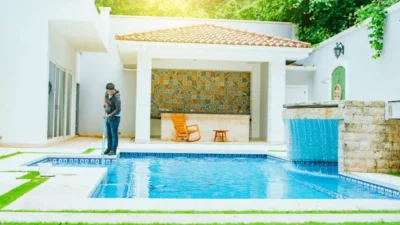Last Updated on July 1, 2025 by Lexy Summer
Living in a compact space doesn’t mean you have to feel cramped. Whether you’re in a cozy apartment or a modest house, the perception of space often matters more than actual square footage.
Interior designers have mastered techniques that transform even the tiniest rooms into spaces that feel open and airy. Let’s explore six professional design strategies that can help you maximize your small living room design without knocking down any walls.
1. Strategic Furniture Selection and Placement
Before diving into specific techniques, it’s important to understand how your furniture choices and arrangement dramatically impact spatial perception. The right pieces positioned thoughtfully can make all the difference.
Choose Scale-Appropriate Pieces That Breathe
Contrary to popular belief, filling a small room with tiny furniture isn’t always the answer. Interior design for small spaces focuses on selecting appropriately scaled pieces that don’t overwhelm the room but still provide comfort and function.
Look for slim profiles with elevated designs, sofas and chairs with visible legs create a sense of airiness as light flows underneath them. The negative space between furniture pieces is just as important as the furniture itself.
Design experts recommend choosing deeper-seated sofas (for comfort) but with slimmer arms and backs to reduce visual bulk. A well-proportioned 78″ sofa will often work better than multiple small chairs that chop up the visual space.
Float Your Furniture Away From Walls
Here’s a counterintuitive trick: pulling furniture slightly away from walls can make your room feel larger. This design technique creates circulation paths that enhance spatial perception.
Instead of pushing everything against the walls, try floating your sofa a few inches away and creating intimate conversation areas. This approach maximizes function without making the room feel crowded. A small area rugs can define these conversation zones while maintaining visual flow throughout the space. Expert designers often use this technique to create distinct functional areas that feel purposeful rather than cramped.
Now that your furniture is thoughtfully arranged, let’s look at how light and color can transform your space completely.
The Magic of Light and Color Psychology
The way we perceive space is dramatically influenced by light and color choices. These elements can make walls appear to recede or advance, creating optical illusions that expand your living area.
2. Strategic Color Palettes That Expand Visual Space
Choosing the right color scheme is one of the most powerful tricks to make a living room bigger. Monochromatic and tonal schemes blur boundaries between surfaces, making the room feel more expansive.
While conventional wisdom suggests only light colors work in small spaces, that’s not entirely true. Dark colors can create depth and coziness when used strategically. The key is consistency; sudden shifts in color create visual stopping points that can make a room feel choppy.
Try color blocking to create depth and dimension. For instance, painting built-ins the same color as your walls helps them recede visually. Extending your wall color onto trim pieces eliminates visual breaks that can make a space feel smaller.
3. Layered Lighting to Create Depth
Strategic lighting is a game-changer in small living room design. Professional designers use a three-layer approach: ambient, task, and accent lighting. Uplighting makes ceilings appear higher. Try wall sconces or torchiere floor lamps that direct light upward. Corner lighting techniques help push walls outward visually, making the room feel wider.
Smart lighting solutions that eliminate floor and table clutter are particularly effective. Consider wall-mounted reading lamps instead of floor lamps, or recessed lighting instead of table lamps to free up precious surface area. With your lighting strategy illuminating the space beautifully, let’s explore visual tricks that further enhance spatial perception.
Visual Tricks That Fool the Eye
Professional designers often employ optical illusions to create the impression of more space. These techniques manipulate how we perceive boundaries and dimensions.
4. Mirrors and Reflective Surfaces as Space Multipliers
Mirrors are perhaps the most powerful tool in a designer’s arsenal for living room decor ideas in tight quarters. They create the illusion of depth by reflecting both light and the image of the room.
Position mirrors strategically to maximize impact across from windows to bounce natural light, at the end of a hallway to extend sightlines, or behind a light source to amplify illumination.
Mirrored or glass furniture reduces visual weight in the room.
A glass coffee table, for example, practically disappears visually while still providing function. Metallic accents and glossy surfaces similarly enhance light reflection throughout the space.
5. Vertical Design Elements That Draw the Eye Upward
Drawing attention upward makes ceilings feel higher and the entire room more spacious. Floor-to-ceiling treatments like draperies hung high above windows create vertical lines that elongate the walls.
Vertical stripes and patterns heighten walls visually. Consider wallpaper with subtle vertical patterns on a feature wall or striped elements in your décor. Hanging elements like pendant lights or even plants in hanging planters create visual interest above eye level.
This capitalizes on often-neglected vertical space while drawing the gaze upward. These visual trickery techniques work hand-in-hand with thoughtful floor and window treatments to maximize the perception of space. A stylish option to enhance this effect is using abstract wallpapers, which add dynamic movement and vertical energy, helping guide the eye upward and expanding the room’s feel.
Floor Coverings and Window Treatments
What’s beneath your feet and around your windows significantly impacts how spacious a room feels. Let’s explore professional approaches to these elements.
Selecting the Right Area Rugs for Visual Expansion
Counterintuitively, a larger area rug often makes a room feel bigger than several small rugs. Space-saving furniture paired with appropriately sized floor coverings creates a cohesive look.
Choose rugs with simple patterns that don’t visually break up the floor space. A rug that allows furniture to sit entirely on it (or at least front legs) creates a defined zone without chopping up the room.
Placement strategies that define zones without dividing the room work best. Consider how traffic flows through the space and position your rug to enhance rather than impede movement.
Window Treatments That Maximize Natural Light
Windows are your allies in making a small space feel larger. The high-and-wide curtain hanging method is a designer favorite Mount curtain rods 4-6 inches above window frames and extending them 8-10 inches beyond each side.
Sheer fabrics filter light without blocking it completely. Light-filtering or sheer curtains maintain privacy while allowing maximum sunlight to flood the room.
For truly small spaces, consider alternatives to traditional curtains. Roller shades, Roman blinds, or even decorative window film can provide privacy without the visual bulk of fabric panels. Now, let’s look at how multi-functional solutions can maximize both space and functionality.
6. Multi-Functional and Space-Saving Solutions
When square footage is limited, each piece in your room should earn its keep. Designers excel at finding clever ways to maximize functionality without adding visual clutter.
Furniture That Serves Multiple Purposes
Multi-functional furniture is essential for interior design for small spaces. Look for pieces that transform or offer hidden storage: ottomans with interior storage, expandable dining tables, or nesting tables that can be separated when needed.
Hidden storage opportunities in seating and tables help keep clutter at bay. Consider sofas with storage underneath, coffee tables with drawers, or side tables with shelving.
The financial benefits of investing in quality multi-functional pieces often outweigh the initial cost, which is why you should invest in furniture that will last you a lifetime, such as solid wood dining room furniture. These versatile items eliminate the need for additional furniture pieces, saving both space and money over time.
Visual Decluttering Strategies
In small rooms, less truly is more. The minimalist approach to accessories and décor keeps visual noise to a minimum, allowing the space to breathe.
Create focal points that direct attention strategically: a striking piece of art, a beautiful light fixture, or an unusual furniture piece gives the eye a place to rest without overwhelming the space.
Embrace “negative space” as a design element rather than emptiness to fill. Those blank areas allow the eye to rest and make the room feel more spacious. These practical solutions work hand-in-hand with some unexpected designer techniques that can transform your space completely.
FAQs
What Works for Creating the Illusion of Space?
Contrary to popular belief, dark colors can work in small spaces. They create depth when used strategically on feature walls or ceilings. The key is consistency in your color palette to avoid visual choppiness that can make a room feel smaller.
What Furniture Arrangement Creates the Most Space?
Creating conversation areas with furniture pulled slightly away from the walls often works better than pushing everything against the perimeter. This counterintuitive approach improves flow and makes the room feel more intentionally designed.
How Can I Add Style Without Overwhelming the Space?
Choose fewer, larger statement pieces rather than many small accessories. One substantial art piece creates more impact than a gallery of smaller frames, while keeping visual clutter to a minimum.
Transforming Your Small Space
Small living rooms come with challenges, but they also offer opportunities for creative living room decor ideas. By implementing these designer tricks, you can create a space that feels open, functional, and stylish. Remember that perception is reality when it comes to spatial design.
Focus on creating the feeling of openness through thoughtful furniture selection, strategic lighting, clever visual tricks, and multi-functional solutions. The most beautiful small spaces aren’t those that try to hide their limitations, but rather those that embrace efficiency and intentionality. With these professional design techniques, your small living room design can become a space you love to live in, no matter its dimensions.

Lexy Summer is a talented writer with a deep passion for the art of language and storytelling. With a background in editing and content creation, Lexy has honed her skills in crafting clear, engaging, and grammatically flawless writing.



